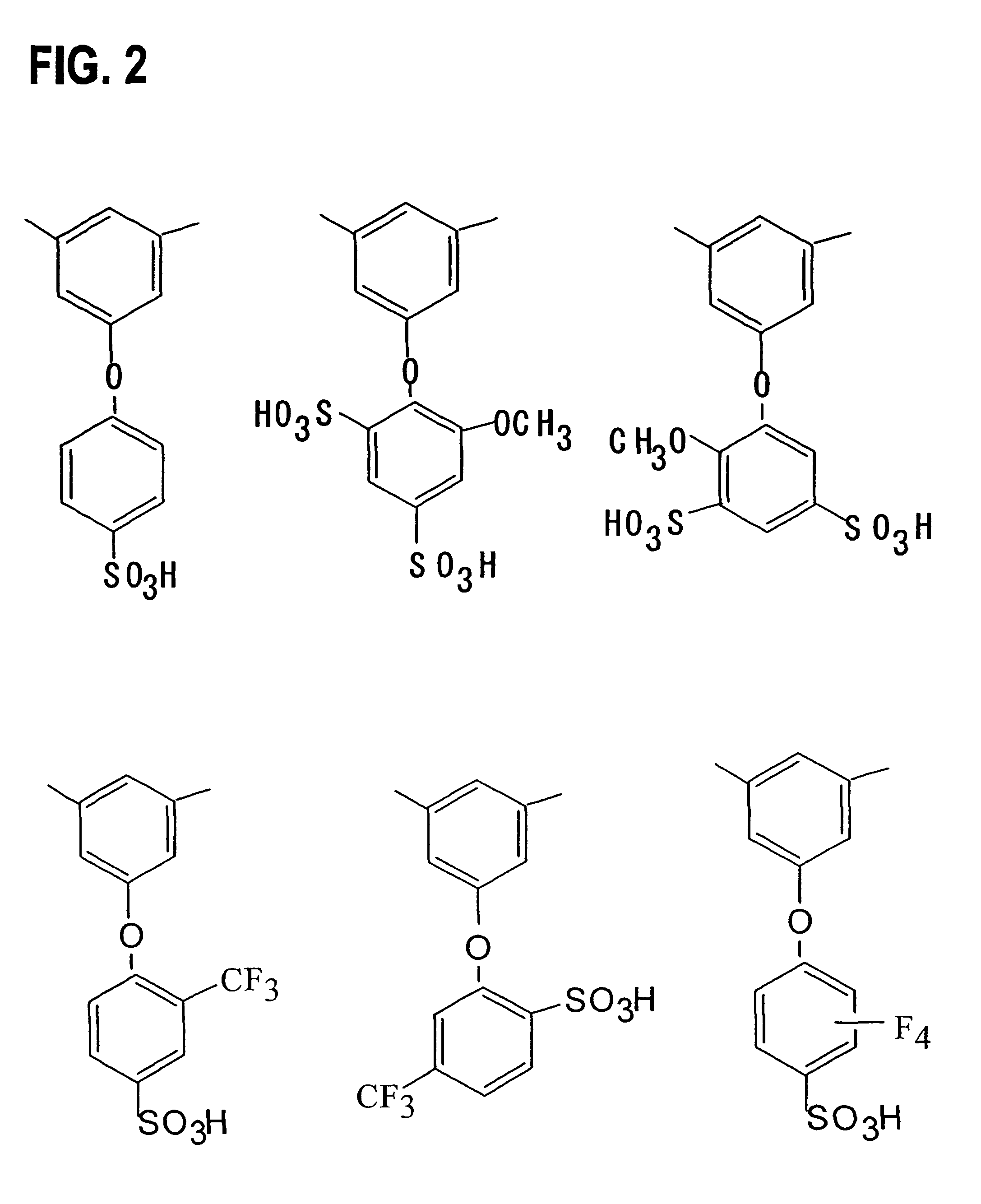Electrolyte composition, solid electrolyte membrane, solid polymer fuel cell and manufacturing method for solid electrolyte membrane
a solid electrolyte membrane and electrolyte technology, applied in sustainable manufacturing/processing, non-aqueous electrolyte cells, final product manufacturing, etc., can solve the problems of inability to obtain sufficient proton conductivity, inability to output energy as electricity, inability to meet the requirements of methanol cross-over, etc., to achieve excellent resistance to acids, low methanol crossover, and high proton conductivity
- Summary
- Abstract
- Description
- Claims
- Application Information
AI Technical Summary
Benefits of technology
Problems solved by technology
Method used
Image
Examples
example 1
Synthesis of Monomers
[0065]Monomers 1-17 were synthesized according to the following procedures. The reaction schemes are shown in FIGS. 4 and 5.
[0066](Monomer 1 and Monomer 2)
[0067]They were synthesized according to the literature procedures (Macromolecules, 1996, vol. 29(3), p. 852). The structure identification was carried out by 1H-NMR, 19F-NMR and mass spectroscopy (MS).
2,4-dichloro-6-(4-fluorophenyl)-1,3,5-triazine—monomer 3
[0068]A THF (tetrahydrofuran) solution (200 mL) of 4-bromofluorobenzene (17.5 g, 0.1 mol) and Mg (2.64 g, 0.11 mol) was stirred for two hours at 30° C., and then refluxed for two hours. This solution was added to a THF solution (200 mL) of cyanuric chloride (21.58 g, 0.120 mol) at −20° C. The mixture was stirred for five hours at −20° C. The solvent was then removed under a reduced pressure.
[0069]The resulting solid was dissolved into dichloromethane, and washed with water twice. The organic phase was dried over anhydrous MgSO4, and the solvent was removed ...
example 2
Synthesis of Polymers
[0087]Polymers 1-12 were prepared according to the following procedures. The routes of the polymerizations are shown in FIGS. 6-9. In FIGS. 6-9, the polymers are shown in the form of potassium salts or sodium salts.
[0088](Polymer 1)
[0089]Monomer 5 (6.4 g, 10 mmol) was dissolved into dry NMP (15 g) in a three-necked, round-bottom flask with a nitrogen purging system. The mixture was refluxed for 16 hours. The reaction mixture was poured into water (50 mL) to separate the polymer, which was dried in vacuo at 80° C. for two days.
[0090]The inherent viscosity of the polymer was 0.38 dL / g. In all the examples, the inherent viscosity was measured at 30° C., for 0.25 g / dL DMSO solutions of polymers, using an Ostwald capillary viscometer.
[0091]A 20% by weight DMSO solution of the obtained polymer was prepared, and was applied onto a glass plate, using a doctor blade having a gap size of 300 μm. The solvent was removed at 50° C. for one hour, 120° C. for one hour and 200°...
example 3
Preparation of Direct Methanol Fuel Cells
[0126]Direct methanol fuel cells having a structure as shown in FIG. 10 were prepared. First, the cathode catalyst layer was formed as follows. Two grams of carbon-supported Pt catalyst particles, in which Pt catalyst having particle size in the range of from 2 nm to 5 nm has been supported on Ketjen black (Ketjen Black EC, a product of Lion Ltd.) at about 50 wt. %, and 22 mL of 4.4 wt. % Nafion in water-2-propanol (Du Pont de Nemours & Co.), were mixed in a ball mill, followed by deaeration to form a paste. The paste was applied onto a Teflon® sheet, and dried at 80° C. for 30 minutes. A cathode catalyst layer was thus formed.
[0127]In the same way, 2 g of Pt / Ru catalyst particles in which a Pt—Ru alloy (molar ratio being 1:1) catalyst having a particle size in the range of from 2 nm to 5 nm was supported on Ketjen black (Ketjen Black EC, a product of Lion Corp.) at about 50 wt. %, and 22 mL of 4.4 wt. % Nafion in water-2-propanol (Du Pont de...
PUM
| Property | Measurement | Unit |
|---|---|---|
| number average molecular weight Mn | aaaaa | aaaaa |
| temperature | aaaaa | aaaaa |
| voltage | aaaaa | aaaaa |
Abstract
Description
Claims
Application Information
 Login to View More
Login to View More - R&D
- Intellectual Property
- Life Sciences
- Materials
- Tech Scout
- Unparalleled Data Quality
- Higher Quality Content
- 60% Fewer Hallucinations
Browse by: Latest US Patents, China's latest patents, Technical Efficacy Thesaurus, Application Domain, Technology Topic, Popular Technical Reports.
© 2025 PatSnap. All rights reserved.Legal|Privacy policy|Modern Slavery Act Transparency Statement|Sitemap|About US| Contact US: help@patsnap.com



